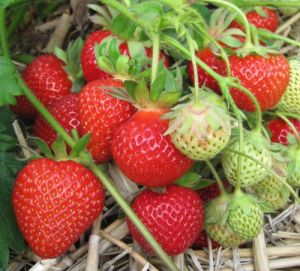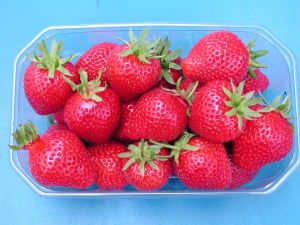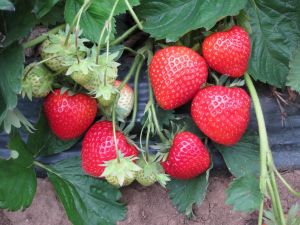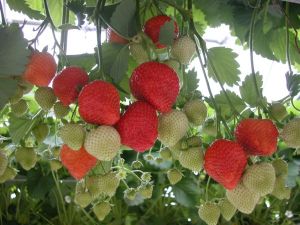Malling Centenary TM |
|
|
|
|
Malling Centenary is an early-mid season variety which produces consistent attractive heart shaped berries. The fruit firmness, flavour, shelf life and Brix levels are excellent and are considered to be much better than Elsanta. Due to its large average berry size and very low % of waste fruit, picking efficiencies with Malling Centenary can show significant improvement on other commercial Junebearers.
Malling Centenary has a reasonable tolerance to Powdery Mildew but does however need some input with plant protection products during high-risk periods.
Malling Centenary does not have a strong resistance to root diseases, and this should be considered when selecting the growing system, production sites and plant treatments.
Special attention should be given to adequate Botrytis control during high risk weather conditions, for best results, Malling Centenary should be grown under protection where possible.
Malling Centenary is particularly suited to protected table tops and glasshouse production systems.
Most UK retailers list Malling Centenary. |
|
|
Click here for Malling Centenary Fruit Production and Propagation Guidelines |
||
Malling Vitality TM |
|
|
 |
Malling Vitality is an early-mid season variety with a very similar harvesting period to Malling Centenary. On some sites Malling Vitality can start production 5-10 days earlier than Malling Centenary. The fruit is displayed well on long trusses for enhanced picking efficiency.
Malling Vitality produces a very high % of good sized, attractive, glossy, pale red class 1 fruits. The fruit is firm and has an excellent shelf life.
Malling Vitality has a good tolerance of root disease and is a good option on sites where Malling Centenary is unsuitable, particularly if over-wintering is required.
|
|
Malling Allure TM |
|
|
 |
Malling Allure is a late season variety, with a harvest 10-12 days later than Elsanta, with a similar, but shorter, season to Florence.
Malling Allure has a very high yield potential (600g+) and produces a high class 1% of large, attractive berries that are lighter in colour than Elsanta. The fruit is consistently firm with an excellent shelf life and an average brix of 8.7°.
This later variety has a useful place in the UK market and will help growers spread out the main season picking once the earlier varieties like Malling Centenary have finished picking.
|
|
Parlando |
|
 |
|
|
Parlando an early-mid season variety from Fresh Forward. This variety is best suited for early substrate production systems.
Parlando has a very high yield potential (650g+). The fruit has a very consistent conic shape, high gloss and bright yellow seeds, making a very attractive berry in the punnet. The fruit is displayed on very long trusses, speeding up harvesting.
Parlando produces very few misshapes and fruit size is very good, however during hot weather fruit size can drop quite quickly, making this selection unsuitable for later 60-day plantings.
The fruit is juicy, with a pleasant texture and has a very good flavour, with a complex balance between sweetness & acidity. During dull weather the fruit can lack sweetness.
Parlando has a good level of resistance to both Powdery Mildew and root diseases such as Phytophthora.
The high evaporation rate of Parlando means a specific watering and climate strategy is advised to prevent drought stress. |
|
Cadenza |
|
 |
 |
A late variety from Fresh Forward specifically bred for soil-grown production systems.
Compact plants with medium length trusses produce very large berries. The fruit size holds up well throughout the harvest.
Cadenza has bright red, attractive fruits with yellow seeds that are very eye-catching in the punnet. The fruit is firm, has a very good flavour and a juicy flesh with a pleasant texture.
The truss length makes this variety unsuitable for substrate cultivation. 40cm should be allowed between plants when planting. |
|
Red Makalu |
|
 |
|
An updated variety information to be published soon.
|
||
Elsanta |
|
 |
 |
Once the mainstay of the UK strawberry industry, Elsanta is a good all-rounder.
Elsanta reliably produces good yields of large, firm, glossy orange/red fruit. The fruit has an excellent shelf life and a good level of flavour.
Although successful cultivation of Elsanta requires intensive input from the grower, it can adapt to many different climatic conditions and multiple growing systems. |
|
Fenella |
|
 |
 |
Fenella is a late season variety with a high yield and is a reliable performer even in poor weather conditions.
Fenella produces glossy orange/red berries with a flat calyx. The flavour is sweet and aromatic with a juicy texture. The vigorous plants have an upright habit with long trusses which display the fruit well.
Fenella has very good resistance to both Verticillium wilt and crown rot along with high rain tolerance so can be grown unprotected.
The 50% pick date is 8 days later than Elsanta. The cropping profile is a more compressed season compared with Elsanta. |
|
Florence |
|
 |
 |
Florence is a late season June bearer, peaking 10-12 days later than Elsanta.
Known for its high yield and strong disease resistance, it is popular throughout Northern Europe. The berries have a sweet, good flavour, but can darken if left on the plant too long.
Regular, high frequency picking is recommended to minimise bruising and maximise shelf life. |
|
Elegance |
|
 |
 |
Elegance is a mid-late season variety with a very high yield and produces nearly all class 1 fruit. Elegance picks over an extended period, often four to five weeks.
Elegance has glossy, bright berries that are orange/red and are a uniform conical shape. Skin is waxy and firm, not susceptible to bruising and has an excellent shelf life, The flavour is good with a juicy texture.
Anecdotal evidence suggests lower feed inputs can improve flavour characteristics with this variety. Elegance is moderately resistant to crown rot and verticillium wilt but is susceptible to powdery mildew. |
|
Verdi |
|
 |
 |
Verdi is a mid-season variety with a low fertilisation requirement. Verdi has a relatively long harvest period when compared to other junebearing varieties.
The fruit has an intense red to deep red colour and an attractive gloss. Early fruits have a wedge shaped appearance but later fruits are a uniform conical shape.
Verdi has excellent resistance to root diseases and Powdery Mildew
|
|







